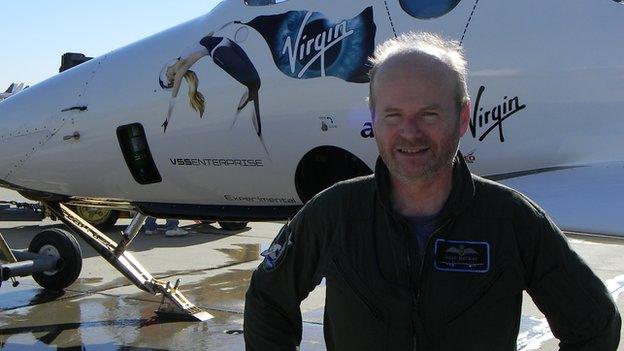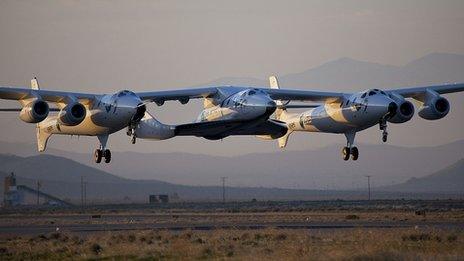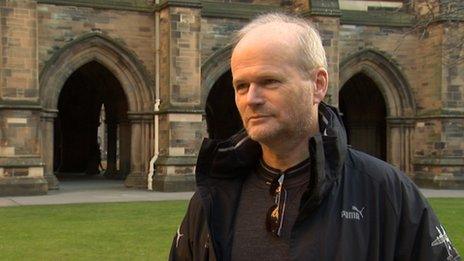David Mackay: The pilot who will fly to space
- Published

Chief Pilot Dave Mackay after his inaugural flight in SpaceShipTwo.
A Scottish pilot could be the first captain to fly tourists into space. David Mackay is the chief pilot for Virgin Galactic, which hopes to take commercial airline flights outside Earth's atmosphere within the next two years.
"I hope to be in space next year," says David Mackay.
The 55-year-old has held a "lofty ambition" to be a spaceman since he was a child in the far north of Scotland in the 1960s.
As a seven-year-old with a love of space and an interest in flying, influenced by fast jets which daily practised their low-flying manoeuvres over his home on the Sutherland coast, he noticed that most astronauts were former military test pilots.
The young Mackay settled on this as a career path for fulfilling his dream.
"Not long after I got my test pilot qualification I realised there was no manned space flight programme in the UK, and there was unlikely to be one," says Mackay.
The Scot took a degree in Aeronautical Engineering at Glasgow University.
He then joined the RAF and served for 16 years but by his late 30s his chances of space flight seemed very slim.

SpaceShipTwo soars through the sky during a test flight in Mojave in the US
Mackay moved into the world of commercial airliners with Virgin Atlantic in 1995.
"Soon after I joined I drove into Heathrow and there was a model of the Space Shuttle in Virgin Atlantic colours and it said something typically Virgin like 'Today the Atlantic, Tomorrow the Moon'," he jokes.
"I guess there was always a chance that something exciting might happen but obviously I did not believe we would be doing commercial space flight."
Now, Mackay is the chief pilot for Virgin Galactic and if it successfully completes its tests, conducted in the Mojave Desert in the US, he could be the first pilot to fly tourists into space.
Virgin announced at Farnborough Air Show in July it had taken deposits from 529 people who want to fly in space.
These are people who will have to part with $200,000 (£128,000) before they board SpaceShipTwo.
Mackay likens it to Charles Lindberg's first solo flight across the Atlantic in 1927.
"That was a demonstration of what was possible," he says.
"Shortly after that other people developed it and now it is possible for anybody to fly across the Atlantic.
"This could be something similar. That first important step."

The mothership (WhiteKnightTwo) and SpaceShipTwo on a test flight
So what will be involved?
"The flight experience will be - to use the American term - 'truly awesome'," says Mackay.
"There will be a three-day training course for the passengers because it will be so amazing that if you were to go in cold it could be mind-blowing."
One major difference from the traditional image of space travel is that it will not be a vertical rocket launch.
The spaceship will be taken to 47,000ft (14km) attached to a "mothership" which supplies pressurisation, air conditioning and electrical power to the spaceship until launch height.
The climb to launch altitude takes about an hour and then the countdown begins.
When the spaceship separates the passengers could get a "lightness in the stomach" as it falls away and then the rocket motor kicks in.
The force of the rocket is about 3.5g - equivalent to the most powerful drag car racer - and it will last for a full minute.
"We are launched horizontally, but immediately the motor starts burning so we pull up into the vertical," says Mackay.

David Mackay studied Aeronautical Engineering at Glasgow University
"You will see the sky go from blue to dark blue to black."
When the motor shuts off the spaceship goes from a massive thrust into weightlessness.
The passengers can then unstrap and float about in zero gravity.
"Everybody I have seen do it so far ends up with a huge cheesy grin on their face," says Mackay.
With the motor thrust off, the spaceship continues to go up into space where passengers will be able to see the curvature of the earth and the thin band of atmosphere above.
When the spaceship reaches its "apogee", at about 360,000ft (110km), it starts to come back down.
The re-entry force is even greater than leaving earth's atmosphere but the seats are in recline to help the passengers withstand forces up to 5g.
When it gets back down to 70,000ft, the spaceship changes from the feather-shape it has adopted for the drop, back into a glider to make the landing.
It sounds like an exhilarating flight. But is it safe?
Successful landing
Mackay says: "I am not going to pretend that flying a spaceship will be as safe as getting in a 747 with four engines for a flight across the Atlantic."
But he says that as a test pilot he has to take tiny steps to make sure every risk is understood and reduced as much as possible.
He says the fact that the spaceship is a glider means that it has a good chance of making a successful landing if the rocket boosters were to fail.
According to Mackay, the mothership has flown more than 100 times and is "pretty much ironed out".
The spaceship has flown 22 glide flights to ensure it can be landed successfully every time and the rocket motor has had about 30 firings.
The next stage is to put the rocket on to the spaceship and start pointing it towards space.
"We should do our first rocket powered flight early in 2013 - then we start to gradually build up, increasing the boost until we go higher and higher and eventually end up in space."
Mackay says it has taken a long to time to get this close but the "lofty ambitions" of his seven-year-old self could be fulfilled.
"I would say if you do have ambitions don't just wait around. Go out and make yourself as well-qualified as possible so you can take that rare opportunity when it comes along."